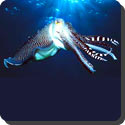 You have probably noticed ‘cuttlebone’ pushed between the bars of a budgerigar’s cage, or washed up on the beach. This ‘bone’ is not really bone at all but the shell of a cuttlefish, which is not a fish but a mollusc. The cuttlefishes, squids and octopuses belong to a group of mollusks called cephalopods and most characterized by a very reduced shell or by not having one at all. The shell is the cuttlefish is completely enclosed by the mantle and, being very light, it helps to keep the animal buoyant.
You have probably noticed ‘cuttlebone’ pushed between the bars of a budgerigar’s cage, or washed up on the beach. This ‘bone’ is not really bone at all but the shell of a cuttlefish, which is not a fish but a mollusc. The cuttlefishes, squids and octopuses belong to a group of mollusks called cephalopods and most characterized by a very reduced shell or by not having one at all. The shell is the cuttlefish is completely enclosed by the mantle and, being very light, it helps to keep the animal buoyant.
The foot of all the cephalopods is modified to form either eight or ten tentacles which surround the head (cephalopod means head-footed). These bear suckers along their length and it is with them that the animals catch their prey. The edge of the mental of the cuttlefish forms two flaps at the sides and by undulating these the animal swims about quite leisurely. In an emergency, greater speed is obtained by forcing out a jet of water from the mantle cavity through a funnel. The funnel can be directed in any direction and if suddenly attacked, the cuttlefish can shoot off out of danger.
 Kids Portal For Parents India Kids Network
Kids Portal For Parents India Kids Network






